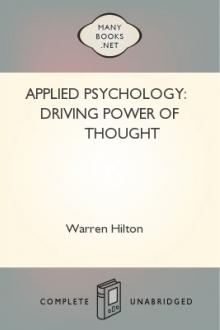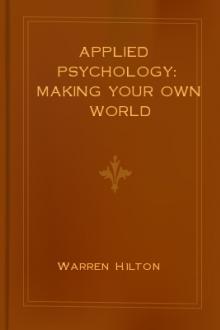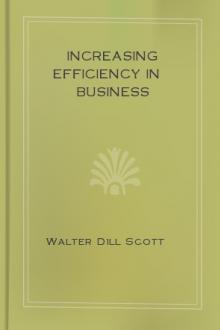Applied Psychology: Driving Power of Thought, Warren Hilton [each kindness read aloud .TXT] 📗

- Author: Warren Hilton
- Performer: -
Book online «Applied Psychology: Driving Power of Thought, Warren Hilton [each kindness read aloud .TXT] 📗». Author Warren Hilton
You should not employ as private secretary a person whose reactions indicate a natural inability to keep a secret. This quality of mind can be simply and unerringly detected by psychological tests.
One quality entering into the ability to keep a secret is the degree of suggestibility of the individual. That person who most quickly and automatically obeys and responds to suggested commands possesses the least degree of conscious self-control. The quality referred to is illustrated by the child's game of "thumbs up, thumbs down," and "Simon says thumbs up" and "Simon says thumbs down." Those persons who are unable to wait for the "Simon says," but mechanically obey the command "thumbs up" or "thumbs down" would be those least able to resist a trap artfully laid to compel them to disclose what they wished to conceal. Like efficiency in observation, attention and memory, however, suggestibility is specific, not general, in character—that is to say, persons may be easily influenced by certain kinds of suggestion while possessing a strong degree of resistance to other kinds. Consequently actual tests of this quality cannot be limited to one method.
For purposes of illustration, here is a simple form of what is known as the "line" test for suggestibility. The subject is seated about two feet away from and in front of a revolving drum on which is a strip of white paper. On this strip of white paper are drawn twenty parallel straight lines. These lines begin at varying distances from the left-hand margin. Each of the first four lines is fifty per cent longer than the one before it, but the remaining sixteen lines are all of the same length.
The examiner says to the subject, "I want to see how good your 'eye' is. I'll show you a line, say an inch or two long, and I want you to reproduce it right afterwards from memory. Some persons make bad mistakes; they may make a line two inches long when I show them one three inches long; others make one four or five inches long. Let's see how well you can do. I shall show you the line through this slit. Take just one look at it, then make a mark on this paper [cross-section paper] just the distance from this left-hand margin that the line is long. Do that with each line as it appears."
The lines are then shown one at a time, and after each is noted it is turned out of sight. As the lines of equal length are presented, the examiner says alternately, "Here is a longer one," "Here is a shorter one," and so on. The extent to which these misleading suggestions of the examiner are accepted and acted upon by the subject in plain violation of the evidence of his senses tests in a measure his suggestibility, his automatic, mechanical and immediate responsiveness to the influence of others and his comparative lack of strong resistance to such outside influences. Inability to satisfactorily meet this and similar tests for suggestibility would indicate an unfitness for such duties as those required by a private secretary, who must at all times have himself well in hand and not be easily lured into embarrassing revelations.
You should not employ as stenographer a person whose time-reactions indicate a slowness of auditory response or an inability to carry in mind a long series of dictated words, or whose vocabulary is too limited for the requirements of your business.
The quickness of auditory response may be determined either by speech tests or by instrumental tests. In either case the acuteness of hearing of the applicant is measured by the ability to promptly and correctly report sounds at various known ranges, the acuity of the normal ear under precisely similar conditions having been previously determined. Speech involves a great variety of combinations—of pitch, accent, inflection and emphasis. Consequently a scientific speech test involves the preparation of lists of words based upon an analysis of the elements of whispered and spoken utterance. This work has been done, and such lists and tests are available.
For testing the ability to remember a series of dictated words the following lists of words are recommended:
The examiner should repeat these lists of words to the subject one at a time, alternating the concrete and abstract lists. To insure the presentation of the words with an even tempo, a metronome may be had by simply swinging a small weight on a string, having the string of just sufficient length so that the beats come at intervals of one second. Each word should be pronounced distinctly in time with the beat of the metronome, but without rhythm. After each list has been pronounced, have the subject write the list from memory. The lists thus made up by the subject from memory are then to be inspected with reference to the following points:
1. Memory errors (omissions and displacements), concrete lists.
2. Memory errors (omissions and displacements), abstract lists.
Every omission counts two errors; every displacement counts two-thirds when the displacement is by one remove only, one and one-third when by more than one move.
3. Insertions. These are words added by the subject. They count for two errors each, unless the added word resembles the word given in sound, in which case it counts one and one-third.
4. Perseverations. These are reproductions in a given series of words already given in a previous series. If frequent, this indicates a low order of intelligence, with weak self-control and poor critical judgment. Each perseveration counts four.
5. Substitution of synonyms, when a word of like meaning but different sound is substituted for the word given; counts one and one-third.
An approximate determination of the range of vocabulary of your prospective stenographer can be had by the use of the following comparatively short and simple test.
Hand the applicant a printed slip bearing the list of one hundred words given here and ask him to mark the words carefully according to these instructions.
Place before each word one of these three signs:
(I) A plus sign (+) if you know the word.
(II) A minus sign (-) if you do not know the word.
(III) A question mark (?) if you are in doubt.
When you have finished, count the marks and fill out these blanks, making sure that the numbers add to one hundred.
By adding find the total number of "plus" marks on the applicant's slip. Multiply this number by 280, and you will then have obtained the applicant's absolute vocabulary.
An absolute vocabulary of twenty thousand words or over may be graded as excellent; 17,500 to 20,000 words, good; 15,000 to 17,500, fair; and below 15,000, poor.
You should not employ as train-dispatcher a person whose time-reactions indicate a tendency to confuse associated ideas. The associated ideas may be related in time, place or a variety of ways, and the memory of one who has an inherent tendency to substitute an associate for the thing itself is a treacherous instrument. The tendency to confuse associated ideas can be measured by psychological tests.
Your own knowledge of the work of the world will suggest other employments besides that of train-dispatcher in which such a test could be used in hiring men to the improvement of the service.
The employment of psychological tests in the detection of crime is fast supplanting the brutalities of the "third degree."
Thus, for example, by the use of highly sensitive instruments we are able to detect the quickened heart-beat, the shudder, and other evidences of emotion not otherwise discernible, but due to the deliberate presentation of the details and evidences of a crime. Though the subject may not himself be aware of the slightest physical expression of emotion, these signs of a disturbed mentality are unerringly revealed by the delicate instruments of the psychologist.
In some factories the operative is called upon to simultaneously keep watch over a large number of parts of a moving mechanism, and to note and quickly correct a disturbance in any part. Eye and ear must have a wide range, must be able to take account of a large number of operations widely separated in space.
For the scientific determination of the operative's range of visual attention, the "disc tachistoscope," shown facing page 106, may be used. This is a form of short-exposure apparatus. The essential idea is to furnish a field upon which the subject may for a moment fasten his attention, and then to substitute for this field another containing certain prepared test-material. This last field is exposed for but a brief instant and removed, and the subject is then called upon to report all that he has seen during the last exposure. Tests of this kind have demonstrated that the range of visual attention is a comparatively constant quantity with each individual, having but little relation to general ability or intelligence and being but little affected by practice.
It matters not how painstaking the individual may be, he will fail in a test of this kind and at work of this kind if the type of attention that Nature gave him is unfitted for such an "expanded" watchfulness. Yet in any type of work requiring a focusing of the attention upon a minute operation so as to note nice discriminations and detect subtle differences, he might prove a





Comments (0)